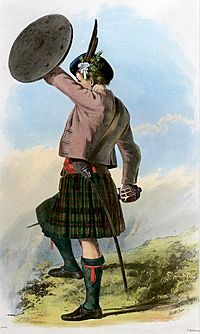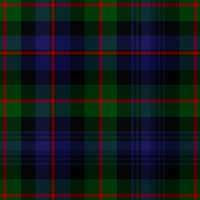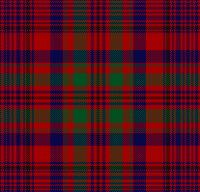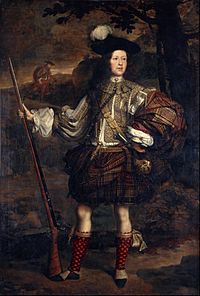Clan Murray facts for kids
Quick facts for kids Clan Murray |
|||
|---|---|---|---|
| Moireach | |||
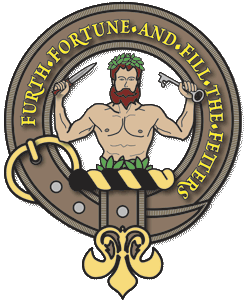
Crest: On a Wreath Or and Sable a demi-savage Proper wreathed about the temples and waist with laurel, his arms extended and holding in the right hand a dagger, in the left a key all Proper.
|
|||
| Motto | Furth fortune and fill the fetters | ||
| Profile | |||
| Region | Highlands and Lowlands | ||
| Plant badge | Butcher's Broom, or Juniper | ||
| Pipe music | The Atholl Highlanders | ||
| Chief | |||
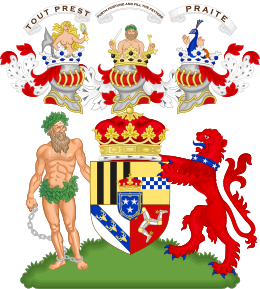 |
|||
| Bruce Murray | |||
| 12th Duke of Atholl | |||
| Seat | Blair Castle | ||
| Historic seat | Bothwell Castle | ||
|
|||
|
|||
|
|||
|
|||
Clan Murray is a famous Scottish clan from the Highlands. The leader of Clan Murray is known as the Duke of Atholl. The family started in Scotland in the 1100s. They were called the Morays of Bothwell.
Later, in the 1500s, another part of the family, the Murrays of Tullibardine, became the main chiefs. They were given the title Earls of Tullibardine in 1606. The first Earl of Tullibardine married a woman who was heir to the Atholl family. This made Atholl a Murray earldom in 1626. The Murray Earl of Atholl became a Marquess in 1676 and then a Duke in 1703.
The Murray chiefs were very important in Scottish history. They supported William Wallace and Robert the Bruce during the Wars of Scottish Independence in the 1200s and 1300s. The Murrays also mostly supported the House of Stuart during the Jacobite risings in the 1700s. Clan Murray is special because they have the only private army in Europe. It is called the Atholl Highlanders.
Contents
History of Clan Murray
How the Clan Started
The first known ancestor of Clan Murray was a man named Freskin. He lived in the 1100s. Some people think he was from the Picts, an ancient Scottish group. But it is more likely he was a Flemish knight. These knights were tough warriors hired by Norman kings to control new lands.
David I of Scotland, who grew up in England, used knights like Freskin to manage his kingdom. He gave Freskin land in West Lothian. The old Pictish kingdom of Moray (Moireabh in Scottish Gaelic) was also given to Freskin. This ended the power of the old Moray royal family. Freskin and his sons married into the old Moray family to become even stronger.
Freskin's family took the name de Moravia, which means "of Moray" in the Norman language. This name later became 'Murray' in the Lowland Scottish language. The first Earls of Sutherland (leaders of Clan Sutherland) came from Freskin's oldest grandson, Hugh de Moravia. The chiefs of Clan Murray came from Freskin's younger grandson, William de Moravia.
Sir Walter Murray became the Lord of Bothwell in Clydesdale. He gained this title by marrying a woman from the Clan Oliphant. In 1255, he became a leader of Scotland. He also began building Bothwell Castle. This castle became one of the strongest forts in Scotland. It was the home of the Clan Murray chiefs until 1360. Then, it went to the Clan Douglas.
Fighting for Scottish Independence
During the Wars of Scottish Independence, Andrew Moray fought for Scotland's freedom against Edward I of England. William Wallace joined him. Andrew Moray was killed after the Scottish victory at the Battle of Stirling Bridge in 1297. After his death, Wallace took charge of the Scottish forces. Some people believe the war might have been different if Moray had lived. He was a very skilled battle leader, which Wallace was not.
Andrew Moray's son was Sir Andrew Murray, the 4th Lord of Bothwell. He was also the third leader of Scotland. He married Christian Bruce, who was the sister of King Robert the Bruce. This Andrew Murray fought in the Battle of Halidon Hill in 1333.
The Bothwell lands went to the Douglas family in 1360. This happened when the fifth Murray Lord of Bothwell died from the plague. His wife, Joan, then married Archibald the Grim, who later became the Earl of Douglas.
Clan Conflicts in the 1400s and 1500s
The Murrays did not fight with their neighbors as much as some other clans. But there was one important event called the Battle of Knockmary in 1490. In this battle, the Murrays of Auchtertyre fought against the Clan Drummond.
In 1562, at the Battle of Corrichie, Clan Murray supported Mary, Queen of Scots. They fought against George Gordon, 4th Earl of Huntly.
Many different parts of Clan Murray argued over who should be the chief. It was not until the 1500s that the Murrays of Tullibardine were clearly seen as the main chiefs. They used the Murray family crest without any changes in 1542. This was before the official register of arms was created in 1672.
The Murrays of Tullibardine claimed to be chiefs because they were descendants of Sir Malcom. He was the sheriff of Perth around 1270 and the younger brother of the first Lord of Bothwell. The Murrays of Tullibardine became stronger as chiefs with two special agreements. These were made in 1586 and 1598. In these agreements, John Murray, who later became the first Earl of Tullibardine, was recognized as the chief by many Murray landowners. This included the Morays of Abercairny in Perthshire.
In the 1594, the Murrays fought with Archibald Campbell, 7th Earl of Argyll, the chief of Clan Campbell. They fought against George Gordon, 1st Marquess of Huntly, the chief of Clan Gordon, at the Battle of Glenlivet.
The 1600s and Civil War
In the early 1600s, a serious conflict happened between the Murrays of Broughton and Clan Hannay. This fight led to the Hannays being declared outlaws.
Sir John Murray of Tullibardine (1548-1613) became the first Earl of Tullibardine in 1606. His son, William Murray, 2nd Earl of Tullibardine, married Dorothea Stewart. She was the heir to the Earls of Atholl. The Atholl earldom then became a Murray earldom in 1629. It became a marquessate in 1676.
The chief of Clan Murray, James Murray, 2nd Earl of Tullibardine, strongly supported King Charles I. He welcomed the royalist army leader, James Graham, 1st Marquess of Montrose, at Blair Castle in 1644. He also gathered 1,800 men to fight for the king. These extra men helped Montrose win the Battle of Tippermuir in 1644.
The 1700s and Jacobite Risings
In 1703, the Murrays, who were already Earls and Marquesses of Atholl, became Dukes of Atholl. This was the highest title in the peerage.
War in France
John Murray, Marquess of Tullibardine, died fighting for the British in the Battle of Malplaquet (1709). This was a big battle in the War of the Spanish Succession between France and a British-Dutch-Austrian alliance. In 1745, Lord John Murray's Highlanders fought for the British against the French at the Battle of Fontenoy.
The Jacobite Rising of 1715
During the Jacobite rising of 1715, the Atholl men (Clan Murray) had 1,400 soldiers. They were split into four groups. Each group was led by William Murray, Marquess of Tullibardine, Lord Charles Murray, Lord George Murray, and William Murray, 2nd Lord Nairne.
At the Battle of Sheriffmuir, Tullibardine acted as a main general for the Jacobite army. His own group of Athollmen was temporarily led by his cousin. The battle ended without a clear winner. Both sides claimed they won.
The Jacobite Rising of 1719
At the Battle of Glen Shiel in 1719, Clan Murray men fought for the Jacobite cause. They were led by William Murray, Marquess of Tullibardine. Tullibardine was hurt but escaped to France. The government offered £2,000 for his capture. On July 25, 1745, he landed in Scotland with the Young Pretender (Charles Edward Stuart). This started the Jacobite rising of 1745. A report in 1724 said the Atholl men had about 2,000 fighters.
The Jacobite Rising of 1745
The first Duke of Atholl's younger son was Lord George Murray. He was a Jacobite general. He planned the early successes of the Jacobite rising of 1745. Many military experts believe that if Lord George Murray had been the only leader of the Jacobite army, the Old Pretender (James Francis Edward Stuart) might have become king.
Lord George's older brother, who became the next duke, supported the British government. George's half-brother, Lord John Murray, became a Colonel in the 43rd Regiment of Foot in April 1745. Because of this, at the Battle of Prestonpans in September 1745, there were Murray soldiers fighting on both sides. Lord George Murray later led the Jacobite attack at the Battle of Falkirk (1746) and the Battle of Culloden (1746). He died in another country in 1760.
After the Battle of Culloden, on April 27, 1746, William Murray, Marquess of Tullibardine, who had landed with the Jacobite leader, Charles Edward Stuart, surrendered. He was not well and was tired. He was taken to the Tower of London, where he died on July 9. Lord George Murray escaped to Europe in December 1746. He was welcomed in Rome by the Prince's father, the "Old Pretender" (James Francis Edward Stuart). He was given money to live on. However, when Murray went to Paris the next year, the Prince refused to meet him. Murray lived in many places in Europe for years. He died in Medemblik, Holland, on October 11, 1760, at 66 years old.
The Atholl Highlanders
The Battle of Culloden was the last time the Highlanders of Atholl went to war. But the Murray chief's special guard, called the Atholl Highlanders, is still unique. It is Europe's only legal private army. In 1845, Queen Victoria gave special flags to the Atholl Highlanders.
Castles of Clan Murray
Many castles have been owned by Clan Murray. Here are some of them:
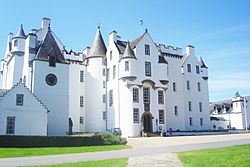


- Blair Castle is the current home of the chief of Clan Murray, the Duke of Atholl. The castle is now a large white mansion. It includes parts of an old castle from the 1200s. The Clan Comyn once had a fort at Blair Castle. Then the Stewart Earls of Atholl owned it. But in 1629, it went to the Murrays through marriage. They became Earls, Marquesses, and Dukes of Atholl.
During the Scottish Civil War, James Graham, 1st Marquess of Montrose, used Blair Castle. It was a meeting point before the Battle of Tippermuir. In 1653, the castle was attacked and partly destroyed by Oliver Cromwell's forces. However, the castle was still strong enough for the Earl of Atholl to try and take it back the next year. John Graham, 1st Viscount Dundee (Bonnie Dundee) kept soldiers at the castle. His body was brought back there after he died at the Battle of Killiecrankie in 1689.
During the Jacobite rising of 1745, Charles Edward Stuart (Bonnie Prince Charlie) stayed at the castle. But the next year, British soldiers took over the castle. It was then attacked and damaged by Jacobites led by Lord George Murray. This was the last time a castle in Britain was attacked in this way. In 1787, the famous poet Robert Burns visited the castle. The castle is also home to the Atholl Highlanders. They have their yearly spring gathering there. Even though Blair Castle is still the home of the Duke of Atholl, he now lives in South Africa. The castle is open for people to visit.
- Bothwell Castle, a few miles north-west of Hamilton, South Lanarkshire, belonged to the Murrays (or Morays) from the mid-1100s. It had been given to them by the Clan Oliphant. During the Wars of Scottish Independence, Bothwell Castle was taken by the English and Scots many times. It was in a very important location. The castle was the main base for the English leader Aymer de Valence, 2nd Earl of Pembroke. But it was given to the Scots in 1314. The main tower was pulled down then. Even though it was later made stronger, it was never as grand as before. Edward Balliol rebuilt the castle. But around 1337, the Scots took it again. Sir Andrew Murray damaged it once more. The last Murray lord of the castle died from the plague around 1360. The castle then went to the Earl of Douglas.
- Tullibardine Castle was about two miles north of Auchterarder, Perthshire. It was a large building. The nearby Tullibardine Chapel was built by Sir David Murray of Tulliebardine in 1446. The Murrays have used it as a burial place since the Protestant Reformation. The chapel is now looked after by Historic Scotland and is open to the public. The castle belonged to the Murrays from 1284. Andrew Murray of Tullibardine supported Edward Balliol. He played an important part in the victory at the Battle of Dupplin Moor. Because of this, he was executed for treason in 1332. The Murrays of Tullibardine later fought at the Battle of Flodden in 1513. They supported Mary, Queen of Scots. But they turned against her when she married the Earl of Bothwell. Sir John Murray was made Earl of Tullibardine in 1606. This title was changed to Marquess of Tullibardine in 1676. William Murray, Marquess of Tullibardine, supported the Jacobite risings of 1715, 1719, and 1745. He died while imprisoned in the Tower of London in 1746.
- Huntingtower Castle north-west of Perth is a well-kept castle. It has two towers, one from the 1400s and one from the 1500s. The Clan Ruthven first owned the castle. It was known as Ruthven Castle. But the property was taken away from them after the Gowrie Conspiracy in 1660. The castle then went to William Murray, Earl of Dysart. After that, it went to the Murrays of Tullibardine. Then it went to the Murray Marqueses and Dukes of Atholl. Huntingtower Castle was where the Jacobite leader Lord George Murray was born. It was sold in 1805. Now, Historic Scotland looks after it, and it is open to the public.
- Balvaird Castle, four miles south of Bridge of Earn, Perthshire, is a well-preserved L-shaped tower house. It first belonged to the Clan Barclay. But it went to the Murrays of Tullibardine in 1500. It was part of the old Lordship and Barony of Balvaird.
- Scone Palace two miles north of Perth was built in 1802. But it includes older parts that might be from 1580. The kings of Scots were crowned at Scone. After the Reformation, Scone went to the Ruthvens. But after the Gowrie Conspiracy, it was given to the Murrays. This was because Sir David Murray of Gospertie had helped save the king's life during the conspiracy. These Murrays became Viscounts of Stormont in 1602 and Earls of Mansfield in 1776. In 1716, James Francis Edward Stuart held court at Scone. James Murray, the second son of the fifth Viscount, supported the Jacobites and escaped to France.
- Comlongon Castle, eight miles south-east of Dumfries, was owned by the Murrays of Cockpool from 1331. It is a strong tower that is five stories tall. It stands next to a large house with castle-like features.
Clan Chief
- The current Clan chief is Bruce Murray, 12th Duke of Atholl. He also holds many other titles, like Marquess of Atholl and Earl of Atholl.
Clan Badges and Crest
The Clan motto is Furth, Fortune, and Fill the Fetters. This means something like: Go out and fight your enemies, have good luck, and come back with prisoners. The half-savage badge was a favorite of the last Duke of Atholl. The Clan still uses it to show respect.
An older badge shows a mermaid holding a mirror in one hand and a comb in the other. Its motto is Tout prêt, which is Old French for all ready. This badge is found in many old books and is still a valid symbol for the Murrays.
See also


